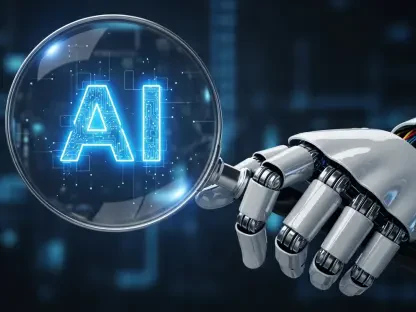In the fast-paced digital landscape, businesses continually seek innovative methods to enhance efficiency and adapt to an ever-evolving environment. A pivotal shift in service delivery is fueled by the integration of Artificial Intelligence (AI) and Low-Code Development Platforms (LCDPs). This dynamic duo not only redefines IT support and customer service but sets new standards in speed, adaptability, and personalization. By combining AI with low-code platforms, organizations create intelligent and scalable ecosystems capable of meeting the demands of today’s highly digital economy, where traditional service models often fall short.
Transforming IT Support and Customer Service
Enhancing Service Delivery and Speed
The convergence of AI and low-code platforms offers a solution to one of the biggest challenges faced by IT support and customer service teams—how to maintain high-speed service delivery without sacrificing quality. Low-code platforms provide an environment where applications can be developed swiftly using user-friendly interfaces, pre-built templates, and visual tools, significantly reducing development timelines. This is particularly beneficial for IT support functions, allowing quick modifications and deployments necessary when responding to sudden changes like product launches or compliance rules updates.
AI complements low-code technologies by adding an intelligence layer that shifts services from reactive to predictive. Capabilities such as natural language processing, sentiment analysis, and predictive analytics enhanced through AI can significantly improve service outcomes. Chatbots powered by AI handle routine tasks, freeing human agents to focus on more complex issues. Furthermore, AI facilitates intelligent ticket routing by analyzing ticket context to assign inquiries to the most suitable agents, thereby reducing resolution times and increasing customer satisfaction. This pairing fundamentally alters how support services operate, delivering a blend of speed and intelligence.
Overcoming Traditional Limitations
Historically, traditional service systems, characterized by manual workflows and separate systems, have struggled to cope with modern demands, resulting in fragmented solutions and delays. The introduction of AI and low-code platforms effectively addresses these constraints. AI-driven analytics enable the extraction of actionable insights from vast data sets without requiring extensive input from specialized data scientists. Meanwhile, low-code frameworks empower non-technical users to participate in developing and refining service tools, bridging the gap between IT and business operations.
This integration promotes a culture of innovation where IT and customer service personnel work collaboratively. Through low-code platforms, business users—often referred to as citizen developers—have the tools needed to design responsive applications rich with embedded AI functionalities, such as pre-built models and API integrations. The synergy between AI and low-code development not only solves present-day service bottlenecks but also aligns solutions closely with operational realities, driving more meaningful and immediate improvements in service delivery.
AI and Low-Code in Practical Applications
Real-World Impacts Across Industries
The practical implementation of AI and low-code platforms spans diverse industries, making substantial contributions to improving service quality. In IT support, intelligent service desks automate ticket classification, prioritization, and resolution processes, reducing human workload and accelerating service times. AI-powered chatbots efficiently manage routine inquiries, like password resets, ensuring seamless operation and stability. In customer service domains, these technologies facilitate 24/7 self-service portals that adapt to user behaviors, autonomously offering solutions or escalating issues to human operators when necessary.
In the telecommunications sector, companies utilize AI and low-code technologies to proactively detect network disruptions, notifying customers and mitigating service interruptions. In the banking industry, AI enhances the precision of fraud detection mechanisms, while healthcare providers capitalize on low-code tools to build patient support systems that continuously adapt to individual patient needs. These examples demonstrate the agility of systems underpinned by AI and low-code, poised for real-time adaptations via continuous insights and user feedback integration.
Scaling Operations Without Complexity
As businesses expand, the need for scalable yet uncomplicated service solutions becomes paramount. One of the most significant advantages of combining AI and low-code capabilities is the ability to scale operations seamlessly without introducing complex dependencies. Low-code development allows the rapid deployment of new workflows, dashboards, and customer interaction points, simplifying the response to growing support demands without major engineering efforts.
AI adds value by making these workflows increasingly intelligent, automating and refining processes over time. The integration with existing enterprise systems like CRM and ERP solutions means businesses can enhance their support services with minimal disruption. This integration becomes essential in developing a comprehensive support model that is both intelligent and expandable, ultimately positioning organizations well to handle future growth and complexities with agility and precision.
The Impending Shift Toward Autonomous Systems
Future of Autonomous and Personalized Services
The trajectory of IT support and customer service is set towards more autonomous and personalized domains, a vision gradually unfolding through the fusion of AI and low-code platforms. These technologies lay the groundwork for systems capable of autonomously adapting to user interactions to optimize outcomes. IT service desks may soon be able to pre-emptively address issues before users report them, and customer service systems could recognize dissatisfaction signs early and address them quickly.
This progression toward greater autonomy and personalization is not theoretical but is actively being implemented by forward-thinking organizations. The seamless integration of AI in low-code systems heralds a new era where service processes are not just reactionary but continuously learning and improving, creating smarter systems that evolve alongside business and user needs.
Security, Governance, and Ethical AI Practices
With increased flexibility and the rapid adoption of AI and low-code technologies, addressing security, governance, and ethical considerations becomes crucial. Leading low-code platforms are designed to support enterprise-level security requirements, including features like role-based access, data encryption, audit trails, and API monitoring. Organizations must implement oversight mechanisms to govern AI services through centralized models to ensure compliance, fairness, and privacy while encouraging innovation.
Furthermore, AI explainability remains paramount to understand models’ decision-making processes. Providing users with insights into AI functioning aligns with ethical AI practices and fosters trust among stakeholders. As AI and low-code integrations become the norm, leaders must execute robust governance strategies, balancing security with innovation to reinforce a sustainable, ethical operational environment.
Charting a Path Forward
In today’s rapidly progressing digital landscape, businesses are constantly on the hunt for novel strategies to boost their efficiency and swiftly adapt to the ever-changing environment. One of the most significant transformations in service delivery arises from the integration of Artificial Intelligence (AI) with Low-Code Development Platforms (LCDPs). This powerful combination reshapes IT support and customer service, establishing new benchmarks in speed, flexibility, and personalization. By merging AI with these low-code platforms, businesses can build smart and scalable ecosystems that effectively address the demands of the modern digital economy. In this climate, traditional service models often prove inadequate; thus, leveraging AI and LCDPs provides a competitive edge. Organizations tapping into these innovative tools are well-positioned to keep pace with evolving consumer expectations and technological advancements, ensuring robust service delivery and enhanced customer experience.









